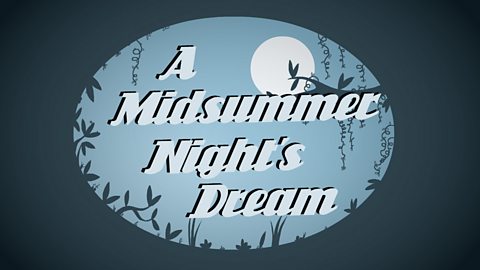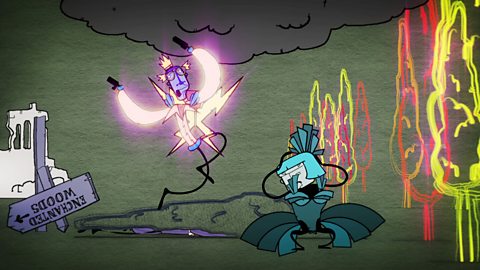Shakespeare is renowned for the language he used and often invented new words. Explore the way he uses rhythm and rhyme and imagery and metaphor in the play, A Midsummer Night’s Dream.
Language overview
The way we write and speak has changed a lot over the past 400 years since Shakespeare wrote his plays, so don’t be put off if you find Shakespeare’s words difficult.
Shakespeare used the following aspects of language in A Midsummer Night’s Dream to make you laugh:
- rhythm and rhyme
- imagery and metaphorA comparison made without using 'like' or 'as', eg 'sea of troubles' and 'drowning in debt'.
Rhythm and rhyme
Shakespeare used rhythm and rhyme in his plays for many different purposes. A strong rhythm gives the language energy. Rhythm also makes the words easier for actors to memorise. Rhythm and rhyme is used to distinguish between certain types of characters. Noble characters usually speak in blank verse, whereas everyday common folk speak just like we do. Characters that are strange and magical often speak in rhyme. Changes in rhythm and rhyme highlight certain aspects of tone and mood. If a noble character breaks from their usual blank verse, it is often a sign that they are unhappy or angry.
Rhythm and rhyme
Analysis of rhythm and rhyme in the play
Why do the Fairies speak in rhyme?
The Fairies are not ordinary everyday creatures. They don’t talk about ordinary everyday things. The rhyme shows how magical and otherworldly they are. Titania and Oberon are the nobles of the fairy kingdom and often break from this rhyming pattern because they are of a different status, like the noble mortals. They also argue like common mortals do.
FAIRIES
Those that ‘Hobgoblin’ call you, and ‘Sweet Puck’,
You do their work, and they shall have good luck.
Act 2 Scene 1
Which characters often speak in iambic pentameter? There are ten syllables to each line and the rhythm itself is like a drumbeat (ti-dum, ti-dum, ti-dum, ti-dum, ti-dum)?
Characters such as the mortals that are noble, well-educated and refined speak in iambic pentameter.
Lysander says to Hermia:
LYSANDER
How now, my love? Why is your cheek so pale?,
How chance the roses there do fade so fast?
Act 1 Scene 1
The words and thoughts in the given quotation could almost begin a poem. Look out for moments when these noble characters break from this rhythm. It’s usually when they are angry or upset about something.
When is the only time Shakespeare allows the Mechanicals to speak in rhyme?
The Mechanicals usually speak in an ordinary conversational way except for when they are performing Pyramus and Thisbe, which is written in very bad rhyme. The rhythm sounds like the nobles’ iambic pentameter. The Mechanicals are trying to sound posh. The rhymes are funny because the words are neither beautiful nor poetic.
PYRAMUS
O, kiss me through the hole of this vile wall.
THISBE
I kiss the wall’s hole, not your lips at all.
Act 5 Scene 1
In Act 2 Scene 2 Titania’s Fairies sing a lullaby to help her sleep.
FIRST FAIRY
You spotted snakes with double tongue,
Thorny hedgehogs, be not seen.
Newts and blindworms, do no wrong,
Come not near our Fairy Queen.
CHORUS
Philomel, with melody
Sing in our sweet lullaby,
Lulla, lulla, lullaby; lulla, lulla, lullaby.
Never harm
Nor spell nor charm
Come our lovely lady nigh.
So good night, with lullaby.
SECOND FAIRY
Weaving spiders, come not here;
Hence, you longlegged spinners, hence!
Beetles black, approach not near;
Worm nor snail, do no offence.
CHORUS
Philomel, with melody
Sing in our sweet lullaby.
FIRST FAIRY
Hence, away! now all is well;
One aloof stand sentinel!
Can you work out the rhyming pattern (which line rhymes with which?)
First Fairy and Second Fairy: ABAB – this is alternate line rhyme.
Chorus: ABBCCBB – after the first line of the chorus, there are a series of rhyming couplets.
The First Fairy finishes with a rhyming couplet.
Imagery and metaphor
Metaphors are detailed comparisons that make writing and speech come alive in our imaginations. On Shakespeare’s stage there were no special effects, the stage was pretty bare except for actors, and the props were few and far between. The writing had to paint exciting scenes in the audience’s minds. This is imagery.
What imagery does Puck use to reassure his master?
Puck promises to Oberon to fetch the magic flower quickly. He says:
PUCK
I’ll put a girdle round about the earth
In forty minutes!
Act 2 Scene 1
He’s promising to go to the other side of the earth and back in forty minutes. Literally he is saying he will put a belt (a ‘girdle’) round the earth’s middle in that time. It paints a picture in the mind of Puck magically zipping round the globe in a streak of light to perform his task for his master.
How does Lysander empathise with Hermia’s distress at her father’s objection to their marriage?
He uses a metaphor. He says:
LYSANDER
The course of true love never did run smooth.
Act 1 Scene 1
This metaphor suggests that love is like a troubled river. It is never still, it makes its way with difficulty overcoming obstacles in its way. The suggestion though is that true love, like the river cannot be stopped. The river will eventually run its course to the sea. True love will overcome all obstacles in the end. And in the play, it does.
How does Shakespeare use words as weapons in the exchange between Lysander and Hermia when he discovers that he hates Hermia having fallen for Helena under the love spell?
Lysander says:
LYSANDER
Get you gone, you dwarf,
You minimus of hindering knot-grass made,
You bead, you acorn.
Act 3 Scene 2
Lysander thinks of all the little things he can and lists them together in a string of insults. Minimus suggests that she’s worth nothing and knot-grass was a weed that was believed to stunt the growth, so he’s suggesting there’s something abnormal about her height. There’s the sense that he’s running out of steam by the time he calls her a bead and an acorn, though.
Did you know?
Shakespeare loved words, and words can be excellent weapons. Conflict makes great drama which is perhaps why insults so often appear in Shakespeare’s plays. Shakespearean insults can be quite rude, but they are also colourful, creative and often very funny.
You probably wouldn’t use: This sanguine coward, this bed-presser, this horseback-breaker, this huge hill of flesh! too often. Or indeed, you starveling, you elf-skin, you dried neat’s tongue, you bull’s pizzle, you stock-fish! O for breath to utter what is like thee! You tailor’s-yard, you sheath, you bowcase; you vile standing-tuck! anymore. But you might have called someone a laughing stock, the devil incarnate or a blinking idiot and each of these come from Shakespeare, too.
In Act 1 Scene 1, Helena is distressed about love. In an extended metaphor she compares love to a boy. This kind of metaphor is called personification because love is given human characteristics in the description.
HELENA
Love looks not with the eyes, but with the mind,
And therefore is winged Cupid painted blind.
Nor hath Love's mind of any judgement taste;
Wings, and no eyes, figure unheedy haste;
And therefore is love said to be a child
Because in choice he is so oft beguiled.
As waggish boys in game themselves forswear,
So the boy Love is perjured every where
In this audio clip, does love sound cruel or kind?
Helena is comparing love to a naughty child, so love here appears cruel, and not at all kind.
Does this metaphor paint a romantic picture of love?
Helena’s experience of love so far is not particularly romantic. She is making a fool of herself for someone who doesn’t love her back. It’s not surprising that she doesn’t have a good word to say on the subject.
More on A Midsummer Night's Dream
Find out more by working through a topic
- count1 of 5

- count2 of 5

- count3 of 5
